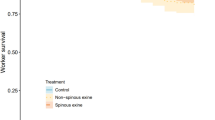Abstract
Two Drosophila species, D. buzzatti and D. aldrichi, coexist on several species of Opuntia cacti in Australia, primarily on O. tomentosa and O. streptacantha in the northern part of the cactus distribution, and on O. stricta in the south. Thorax length of field-collected adults was less, and the variance in length greater, than that for flies reared on simulated rots in the laboratory, indicating that these species are affected by crowding in nature. A larval performance index, measured on simulated cactus rots at low, moderate and high densities in single-species cultures, and at moderate and high densities in mixed-species cultures, was used to compare the relative intensity of intra- and interspecific competition at the same total larval density per 5 g necrotic cactus. Larval performance of both fly species was greatest on O. streptacantha, intermediate on O. tomentosa, and least on O. stricta in both single-species and mixed-species cultures. On O. stricta, the performances of D. aldrichi and D. buzzatii were not different when in single-species cultures, but that of D. aldrichi decreased significantly in mixed-species cultures. On the other two cactus species, the performances of D. aldrichi and D. buzzattii were not different in mixed-species cultures. The order of preferences by adult females for the cacti differed from that for larval performance, with females of both species prefering O. stricta. Analysis of microbial numbers growing on the cacti showed little difference among cacti at the rot age used for testing adult preference, but later growth was greater on O. tomentosa and O. streptacantha, the cacti that best supported larvae. Differential larval performance on O. stricta may contribute to the rare presence of D. aldrichi in the southern part of the cactus distribution, while the superior quality of O. tomentosa and O. streptacantha (larger rot size and higher microbial concentration) may reduce competition and facilitate cocxistence of the fly species in the north.
Similar content being viewed by others
References
Armstrong TP (1992) Olfaction and habitat selection in Drosophila buzzatii. Ph.D. Thesis, Univ. New England, Armidale, NSW, Australia
Atkinson WD (1985) Coexistence of Australian rainforest Diptera breeding in fallen fruit. J Anim Ecol 54:507–518
Barker JSF, Sene FdeM, East PD, Pereira MAQR (1985) Allozyme and chromosomal polymorphism of Drosophila buzzatii in Brazil and Argentina. Genetica 67:161–170
Dobzhansky Th, Pavan C (1950) Local and seasonal variations in relative frequencies of species of Drosophila in Brazil. J Anim Ecol 19:1–14
Fuyama Y (1976) Behavior genetics of olfactory responses in Drosophila. I. Olfactometry and strain differences in Drosophila melanogaster. Behav Genet 6:407–420
Gotelli NJ, Bossert WH (1991) Ecological character displacement in a variable environment. Theor Pop Biol 39:49–62
Grimaldi D, Jaenike J (1984) Competition in natural populations of mycophagous Drosophila. Ecology 65:1113–1120
Jaenike J (1990) Host specialization in phytophagous insects. Annu Rev Ecol Syst 21:243–273
Krebs RA, Barker JSF (1991) Coexistence of ecologically similar colonising species: Intra- and interspecific competition in Drosophila aldrichi and D. buzzatii. Aust J Zool 39:579–593
Krebs RA, Barker JSF (1993) Coexistence of ecologically similar colonising species. II. Population differentiation in Drosophila aldrichi and D. buzzatii for competitive effects and responses at different temperatures, and allozyme variation in D. aldrichi. J Evol Biol (in press)
Mann J (1970) Cacti Naturalised in Australia and their Control. SG Reid, Government Printer, Brisbane
Moore JA (1952) Competition between Drosophila melanogaster and Drosphila simulans. I. Population cage experiments. Evolution 6:407–420
Mulley JC, Barker JSF (1977) The occurrence and distribution of Drosophila aldrichi in Australia. Drosophila Inf Serv 52:151–152
Pipkin SB (1965) The influence of adult and larval food habits on population size of neotropical ground-feeding Drosophila. Am Midl Nat 74:1–27
Robertson FW (1987) Variation of body size within and between wild populations of Drosophila buzzatii. Genetica 72:111–125
Rosewell J, Shorrocks B, Edwards K (1990) Competition on a divided and ephemeral resource: Testing the assumptions. I. Aggregation. J Anim Ecol 59:977–1001
Ruiz A, Heed WB (1988) Host-plant specificity in the cactophilic Drosophila mulleri species complex. J Anim Ecol 57:237–249
SAS Institute (1985) SAS User's Guide: Statistics, Version 6 edn. SAS Institute Inc., Cary, North Carolina
Shorrocks B (1990) Coexistence in a patchy environment. In: Shorrocks B, Swingland IR (eds) Living in a Patchy Environment. Oxford University Press, Oxford, pp 91–106
Shorrocks B, Rosewell J, Edwards K (1990) Competition on a divided and ephemeral resource: Testing the assumptions. II. Association. J Anim Ecol 59:1003–1017
Sokal RR, Oden NL, Barker JSF (1987) Spatial structure in Drosophila buzzatii populations: simple and directional spatial autocorrelation. Am Nat 129:122–142
Sowig P (1986) Experiments on the substrate-preference and the reduction of competition of riparian Carabid beetles. Zool Jb Syst 113:55–77
Starmer WT, Barker JSF (1986) Ecological genetics of the Adh-1 locus of Drosophila buzzatii. Biol J Linn Soc 28:373–385
Thomas RH, Barker JSF (1990) Breeding structure of natural populations of Drosophila buzzatii: effects of the distribution of larval substrates. Heredity 64:355–365
Vacek DC (1982) Interactions between microorganisms and cactophilic Drosophila in Australia. In: Barker JSF, Starmer WT (eds) Ecological Genetics and Evolution. The Cactus-Yeast-Drosophila Model System. Academic Press Australia, Sydney, pp 175–190
Author information
Authors and Affiliations
Rights and permissions
About this article
Cite this article
Krebs, R.A., Barker, J. & Armstrong, T.P. Coexistence of ecologically similar colonising species III. Drosophila aldrichi and D. buzzatii: larval performance on, and adult preference for, three Opuntia cactus species. Oecologia 92, 362–372 (1992). https://doi.org/10.1007/BF00317462
Received:
Accepted:
Issue Date:
DOI: https://doi.org/10.1007/BF00317462




